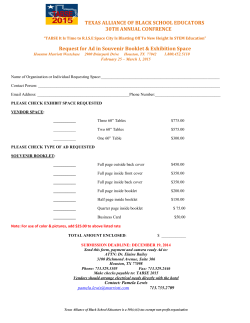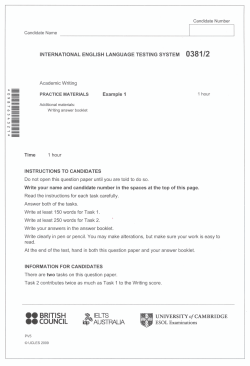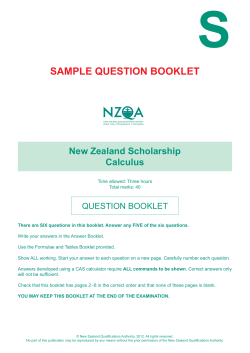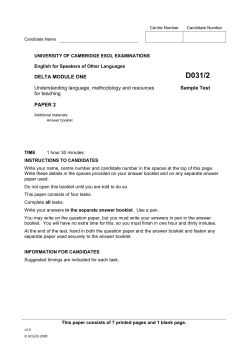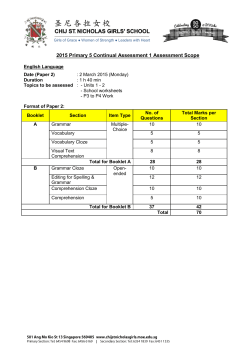
D 0808 PAPER II.p65
Signature and Name of Invigilator OMR Sheet No. : ...................................................... (To be filled by the Candidate) 1. (Signature) Roll No. (Name) (In figures as per admission card) Roll No. 2. (Signature) (In words) (Name) Test Booklet No. D0 8 0 8 PAPERII COMMERCE Time : 1¼ hours] Number of Pages in this Booklet : 24 [Maximum Marks : 100 Number of Questions in this Booklet : 50 ÂÚUèÿææçÍüØô¢ ·ð¤ çÜ° çÙÎðüàæ Instructions for the Candidates 1. 2. 3. 4. 1. ÂãÜðU ÂëDU ·ð¤ ª¤ÂÚU çÙØÌ SÍæÙ ÂÚU ¥ÂÙæ ÚUôÜU ÙÕÚU çÜç¹°Ð Write your roll number in the space provided on the top of this page. This paper consists of fifty multiple-choice type of questions. At the commencement of examination, the question booklet will be given to you. In the first 5 minutes, you are requested to open the booklet and compulsorily examine it as below : (i) To have access to the Question Booklet, tear off the paper seal on the edge of this cover page. Do not accept a booklet without sticker-seal and do not accept an open booklet. (ii) Tally the number of pages and number of questions in the booklet with the information printed on the cover page. Faulty booklets due to pages/questions missing or duplicate or not in serial order or any other discrepancy should be got replaced immediately by a correct booklet from the invigilator within the period of 5 minutes. Afterwards, neither the question booklet will be replaced nor any extra time will be given. (iii) After this verification is over, the Test Booklet Number should be entered in the OMR Sheet and the OMR Sheet Number should be entered on this Test Booklet. Each item has four alternative responses marked (A), (B), (C) and (D). You have to darken the oval as indicated below on the correct response against each item. Example : A B C 2. §â ÂýàÙ-Âæ ×𢠿æâ Õãéçß·¤ËÂèØ ÂýàÙ ãñ¢Ð 3. ÂÚUèÿææ ÂýæÚUÖ ãôÙð ÂÚU, ÂýàÙ-ÂéçSÌ·¤æ ¥æ·¤ô Îð Îè ÁæØð»èÐ ÂãÜðU ÂUæ¡¿ ç×ÙÅU ¥æ·¤ô ÂýàÙ-ÂéçSÌ·¤æ ¹ôÜÙð ÌÍæ ©â·¤è çÙÙçÜç¹Ì Áæ¡¿ ·ð¤ çÜ° çÎØð ÁæØð¢»ð çÁâ·¤è Áæ¡¿ ¥æ·¤ô ¥ßàØ ·¤ÚUÙè ãñ Ñ ÂýàÙ-ÂéçSÌ·¤æ ¹ôÜÙð ·ð¤ çÜ° ©â·ð¤ ·¤ßÚU ÂðÁ¤ÂÚU Ü»è ·¤æ»Á ·¤è âèÜ ·¤ô ȤæǸU Üð¢UÐ ¹éÜè ãé§ü Øæ çÕÙæ SÅUè·¤ÚU-âèÜU ·¤è ÂéçSÌ·¤æ Sßè·¤æÚU Ù ·¤Úð¢UÐ (ii) ·¤ßÚU ÂëDU ÂÚU ÀUÂð çÙÎðüàææÙéâæÚU ÂýàÙ-ÂéçSÌ·¤æ ·ð¤ ÂëDU ÌÍæ ÂýàÙô¢ ·¤è â¢Øæ ·¤ô ¥ÀUè ÌÚUã ¿ñ·¤ ·¤ÚU Üð¢U ç·¤ Øð ÂêÚðU ãñ¢UÐ ÎôáÂêæü ÂéçSÌ·¤æ çÁÙ×ð¢ ÂëDU / ÂýàÙ ·¤× ãô¢ Øæ ÎéÕæÚUæ ¥æ »Øð ãô¢ Øæ âèçÚUØÜU ×ð¢ Ù ãô¢ ¥ÍæüÌ ç·¤âè Öè Âý·¤æÚU ·¤è æéçÅUÂêæü ÂéçSÌ·¤æ Sßè·¤æÚU Ù ·¤Úð¢U ÌÍæ ©âè â×Ø ©âð ÜUõÅUæ·¤ÚU ©â·ð¤ SÍæÙ ÂÚU ÎêâÚUè âãè ÂýàÙ-ÂéçSÌ·¤æ Üð Üð¢Ð U §â·ð¤ çÜ° ¥æ·¤ô Âæ¡¿ ç×ÙÅU çÎØð ÁæØð¢»ðÐ ©â·ð¤ ÕæÎ Ù Ìô ¥æ·¤è ÂýàÙ-ÂéçSÌ·¤æ ßæÂâ Üè ÁæØð»è ¥õÚU Ù ãè ¥æ·¤ô ¥çÌçÚUQ¤ â×Ø çÎØæ ÁæØð»æÐ (iii) §â Áæ¡¿ ·ð¤ ÕæÎ ÂýàÙ-ÂéçSÌ·¤æ ·¤è R¤× â¢Øæ OMR Âæ·¤ ÂÚU ¥¢ç·¤Ì ·¤Úð¢U ¥UõÚU OMR Âæ·¤ ·¤è R¤×¤â¢Øæ §â ÂýàÙ-ÂéçSÌ·¤æ ÂÚU ¥¢ç·¤Ì ·¤ÚU Îð¢Ð 4. ÂýØð·¤ ÂýàÙ ·ð¤ çÜ° ¿æÚU ©æÚU çß·¤Ë (A), (B), (C) ÌÍæ (D) çÎØð »Øð ãñ¢Ð ¥æ·¤ô âãè ©æÚU ·ð¤ Îèæüßëæ ·¤ô ÂðÙ âð ÖÚU·¤ÚU ·¤æÜæ ·¤ÚUÙæ ãñ Áñâæ ç·¤ Ùè¿ð çιæØæ »Øæ ãñÐ ©ÎæãÚUæ Ñ D A B C D ÁÕç·¤ (C) âãè ©æÚU ãñÐ 5. ÂýàÙô¢ ·ð¤ ©æÚU ·ð¤ßÜU ÂýàÙ Âæ I ·ð¤ ¥ÎÚU çÎØð »Øð ©æÚU-Âæ·¤ ÂÚU ãè ¥¢ç·¤Ì where (C) is the correct response. 5. Your responses to the items are to be indicated in the Answer Sheet given inside the Paper I booklet only. If you mark at any place other than in the ovals in the Answer Sheet, it will not be evaluated. 6. Read instructions given inside carefully. 7. Rough Work is to be done in the end of this booklet. 8. If you write your name or put any mark on any part of the test booklet, except for the space allotted for the relevant entries, which may disclose your identity, you will render yourself liable to disqualification. 9. You have to return the test question booklet to the invigilators at the end of the examination compulsorily and must not carry it with you outside the Examination Hall. 10. Use only Blue/Black Ball point pen. 11. Use of any calculator or log table etc., is prohibited. 12. There is NO negative marking. D0808 (i) ·¤ÚUÙð ãñ¢Ð ØçÎ ¥æ ©æÚU Âæ·¤ ÂÚU çÎØð »Øð Îèæüßëæ ·ð¤ ¥Üæßæ ç·¤âè ¥Ø SÍæÙ ÂÚU ©æÚU ç¿ãæ¢ç·¤Ì ·¤ÚUÌð ãñ, Ìô ©â·¤æ ×êËUØ梷¤Ù Ùãè¢ ãô»æÐ 6. ¥ÎÚU çÎØð »Øð çÙÎðüàæô¢ ·¤ô ØæÙÂêßü·¤ Âɸð¢UÐ 7. ·¤ææ ·¤æ× (Rough Work) §â ÂéçSÌ·¤æ ·ð¤ ¥çÌ× ÂëDU ÂÚU ·¤Úð¢UÐ 8. ØçÎ ¥æ ©æÚU-ÂéçSÌ·¤æ ÂÚU ¥ÂÙæ Ùæ× Øæ °ðâæ ·¤ô§ü Öè çÙàææÙ çÁââð ¥æ·¤è Âã¿æÙ ãô â·ð¤, ¤ç·¤âè Öè Öæ» ÂÚU ÎàææüÌð Øæ ¥¢ç·¤Ì ·¤ÚUÌð ãñ¢ Ìô ÂÚUèÿææ ·ð¤ çÜØð ¥ØôØ æôçáÌ ·¤ÚU çÎØð ÁæØð¢»ðÐ 9. ¥æ·¤ô ÂÚUèÿææ â×æ# ãôÙð ¤ÂÚU ©æÚU-ÂéçSÌ·¤æ çÙÚUèÿæ·¤ ×ãôÎØ ·¤ô ÜUõÅUæÙæ ¥æßàØ·¤ ãñ ¥õÚU ÂÚUèÿææ â×æç# ·ð¤ ÕæÎ ¥ÂÙð âæÍ ÂÚUèÿææ ÖßÙ âð ÕæãÚU Ù Üð·¤ÚU ÁæØð¢Ð ·ð¤ßÜ ÙèÜð / ·¤æÜð ÕæÜU ßæ§ZÅU ÂñÙ ·¤æ ãè §SÌð×æÜ ·¤Úð¢UÐ 11. ç·¤âè Öè Âý·¤æÚU ·¤æ ⢻淤 (·ñ¤Ü·é¤ÜðÅUÚU) UØæ Üæ» ÅðUÕÜ ¥æçÎ ·¤æ ÂýØô» ßçÁüÌ ãñÐ 12. »ÜÌ ©æÚU ·ð¤ çÜ° ¥¢·¤ Ùãè¢ ·¤æÅðU ÁæØð¢»ðÐ 10. 1 P.T.O. COMMERCE PAPERII Note : 1. 2. 3. 4. 5. 6. This paper contains fifty (50) objective-type questions, each question carrying two (2) marks. Attempt all of them. Job analysis provides information used for : (A) Organisation chart (B) Policy (C) Procedure (D) Promotion In functional organisation : (A) The organisation is divided according to the type of work involved. (B) The authority flows from the man at the top to the lowest man vertically. (C) Each worker serves only one supervisor (D) The organisation is divided according to the skill required to perform a work. Which of the following relates to training workers ? (A) Job rotation (B) Induction (C) Vestibule (D) Task 360 degree method relates to : (A) Performance appraisal (B) Organisation climate (C) Employees morale (D) Retrenchment method Human relations approach of management is associated with : (A) Abraham Maslow (B) Peter F. Drucker (C) Elton Mayo (D) Herzberg Attrition is related to : (A) Job description (B) Resignation/Termination (C) Job evaluation (D) Merit rating D0808 2 ßæçæØ ÂýàÙÂæII ÙôÅU Ñ §â ÂýàÙÂæ ×𢠿æâ (50) Õãé-çß·¤ËÂèØ ÂýàÙ ãñ¢Ð ÂýØð·¤ ÂýàÙ ·ð¤ Îô (2) ¥¢·¤ ãñ¢Ð âÖè ÂýàÙô¢ ·ð¤ ©æÚU ÎèçÁ°Ð 1. 2. 3. 4. 5. 6. ÁæòÕ çßàÜðáæ mæÚUæ ßã âê¿Ùæ ÂýÎæÙ ·¤è ÁæÌè ãñ çÁâ·¤æ ÂýØæð» ç·¤Øæ ÁæÌæ ãñÐ (A) â´»ÆUÙ ¿æÅüU ×ð´ (B) ÙèçÌ ×ð´ (C) ÂhçÌ ×ð´ (D) ÂÎæðóæçÌ ×ð´ ·¤æØüàæèÜ â´»ÆUÙ ×ð´ Ñ (A) â´»ÆUÙ mæÚUæ ç·¤Øð Áæ ÚUãð ·¤æØü ·¤è ç·¤S× ·ð¤ ¥ÙéâæÚU ©â·¤æ çßÖæÁÙÐ (B) ª¤ßü L¤Â âð ¥çÏ·¤æÚU àæèáü SÍæÙ ÂÚU ÕñÆðU ÃØçQ¤ âð çÙÙÌ× ÃØçQ¤ Ì·¤ Âãé´¿Ìð ãñ´Ð (C) ÂýØð·¤ ·¤æ×»æÚU ·ð¤ßÜ °·¤ çÙÚUèÿæ·¤ ·¤è âðßæ ·¤ÚUÌæ ãñÐ (D) ç·¤âè ·¤æØü ·ð¤ çÙcÂæÎÙ ·ð¤ çÜ° ¥ÂðçÿæÌ ·¤æñàæÜ ÂÚU ¥æÏæçÚUÌ â´»ÆUÙ ·¤æ çßÖæÁÙ ãæðÌæ ãñÐ çÙÙçÜç¹Ì ×ð´ âð ·¤×ü¿æçÚUØæð´ ·ð¤ Âýçàæÿææ âð 緤ⷤæ âÕÏ ãñ? (A) ÁæòÕ ÚUæðÅðUàæÙ (B) ¥æ»×Ù (C) ßñSÅUèØêÜ (D) ·¤æØü 360 çÇU»ýè ÂhçÌ ç·¤ââð âÕ´çÏÌ ãñ? (A) ·¤æØü çÙcÂæÎÙ ×êËØæ´·¤Ù (B) â´»ÆUÙ ßæÌæßÚUæ (C) ·¤×ü¿æçÚUØæð´ ·¤æ ×ÙæðÕÜ (D) ·¤ÅUæñÌè ÂhçÌ ÂýÕÏÙ ×ð´ ×æÙß âÕÏ ÎëçC·¤æðæ ç·¤â çß¿æÚU·¤ âð âÕ´çÏÌ ãñ? (A) ¥Õýæã× ×æSÜæð (B) ÂèÅUÚU °È¤. ÇþU·¤ÚU (C) °ËÅUæðÙ ×æØæð (D) ãñÁ $ Õ»ü °ÅþUèàæÙ ·¤æ ç·¤ââð âÕÏ ãñ? (A) ÁæòÕ çßßÚUæ (B) §SÌèȤæ / Õ¹æüSÌ»è (C) ÁæòÕ ×êËØæ´·¤Ù (D) ×ñçÚUÅU ÚðçÅ´U» D0808 3 P.T.O. 7. 8. 9. 10. 11. 12. The economic reforms have failed to : (A) Keep fiscal deficits to the targeted levels. (B) Fully implement industrial deregulation. (C) Fully open the economy to trade. (D) All of the above Which of the following developments was not noticed during 1991 (economic reforms) ? (A) National debt was nearly 60 percent of the GNP of India. (B) Inflation crossed double digits. (C) Foreign reserves were maintained at a very high level. (D) None of the above. Which of the following statement is incorrect ? (A) Even monopolistic can earn losses. (B) Firms in a perfectly competitive market are price takers. (C) It is always beneficial for a firm in a perfectly competitive market to discriminate prices. (D) Kinked demand curve is related to an oligopolistic market. Which of the following is the best general definition of the study of economics ? (A) Inflation and unemployment in a growing economy. (B) The best way to invest in the stock market. (C) Business decision making under foreign competition. (D) Individual and social choice in the face of scarcity. Which of the following statements is correct ? (A) Under zamindari system, farmers directly paid land revenue to the state. (B) At present, income tax revenues from the agriculture sector are negligible. (C) Commercial banks are providing loans to the agriculture sector at zero interest rate. (D) None of the above. Which of the following statements is incorrect ? (A) About 80 per cent of agricultural area has irrigation facilities. (B) About two third area is rain-fed in India. (C) Productivity per worker in agriculture is much lower than that in industry. (D) Cropping pattern is quite skewed in India. D0808 4 7. 8. 9. 10. 11. 12. ¥æçÍü·¤ âéÏæÚU Øæ ·¤ÚUÙð ×ð´ ¥âÈ¤Ü ÚUãð´ ãñ? (A) ÚUæÁ ·¤æðáèØ ææÅðU ·¤æð ÜçÿæÌ SÌÚU Ì·¤ ÚU¹Ùæ (B) ¥æñlæðç»·¤ ¥çßçÙØ×Ù ·¤æð ÂêæüÌØæ ·¤æØüçßÌ ·¤ÚUÙæ (C) ¥ÍüÃØßSÍæ ·¤æð ÃØæÂæÚU ·ð¤ çÜØð ÂêÚUæ ¹æðÜÙæ (D) ©ÂØéüQ¤ âÖè §Ù×ð´ âð ç·¤â æÅUÙæR¤× ÂÚU 1991 (¥æçÍü·¤ âéÏæÚUæð´) ·ð¤ ÎæñÚUæÙ ØæÙ (A) ÚUæCþèØ «¤æ ÖæÚUÌ ·ð¤ Áè.°Ù.Âè ·¤æ ·¤ÚUèÕÙ 60 ÂýçÌàæÌ Íæ (B) ×éÎýæ SȤèÌè Îé»Ùð ¥´·¤æð ·¤æð ÂæÚU ·¤ÚU »§ü (C) çßÎðàæè çÚU$Áßü ÕãéÌ ©æ SÌÚU ÂÚU ÚU¹ð ÁæÌð Íð (D) ©ÂØéüQ¤ ×ð´ âð ·¤æð§ü Ùãè´ §×ð´ âð ·¤æñÙâæ ·¤ÍÙ »ÜÌ Ùãè´ çÎØæ »Øæ Íæ? ãñ? (A) °·¤æçÏ·¤æÚUè ·¤æð Öè ãæçÙ ©ÆUæÙè ÂǸÌè ãñÐ (B) ÂêæüÌ÷Øæ ÂýçÌØæð»è ÕæÁæÚU ×ð´ Ȥ×ðZ ·¤è×Ìð´ ÌØ ·¤ÚU â·¤Ìè ãñ´Ð (C) ÂêæüÌØæ ÂýçÌØæð»è ÕæÁæÚU ×ð´ ·¤×ü ·ð¤ çÜØð ·¤è×Ìæð´ ×ð´ çßÖðÎ ·¤ÚUÙæ ã×ðàææ ÜæÖÎæØ·¤ ãæðÌæ ãñÐ (D) çß·é´¤ç¿Ì ×æ´» ßR¤ ¥ËÂæçÏ·¤æÚUè ÕæÁæÚU âð âÕçhÌ ãñÐ çÙÙçÜç¹Ì ×ð´ ·¤æñÙâè ¥ÍüàææSæ ·ð¤ ¥ØØÙ ·¤è æðD âæ×æØ ÂçÚUÖæáæ ãñ? (A) çß·¤çâÌ ãæðÌè ¥ÍüÃØßSÍæ ×ð´ ×éÎýæ SȤèçÌ ¥æñÚU ÕðÚUæðÁ»æÚUè (B) SÅæò·¤ ÕæÁæÚU ×ð´ çÙßðàæ ·¤ÚUÙð ·¤æ æðD ÌÚUè·¤æ (C) çßÎðàæè ÂýçÌØæðç»Ìæ ·ð¤ ¥Ì»üÌ ÃØæÂæçÚU·¤ çÙæüØ ÜðÙæ (D) ¥Öæß ·ð¤ â×ÿæ ÃØçQ¤»Ì ¥æñÚU âæ×æçÁ·¤ çß·¤Ë (ÂâÎ) §Ù×ð´ âð ·¤æñÙâæ ·¤ÍÙ âãè ãñ? (A) Á×è´ÎæÚUè ÂýÍæ ·ð¤ ¥Ì»üÌ, ç·¤âæÙ ÚUæØ ·¤æð âèÏð Ü»æÙ ÎðÌð ÍðÐ (B) ßÌü×æÙ â×Ø ×ð´, ·¤ëçá ÿæðæ âð ¥æØ·¤ÚU ÚUæÁSß Ù»Ø ãñ´Ð (C) ßæçæçØ·¤ Õñ´·¤ ·ë¤çá ÿæðæ ·¤æð àæêØ ØæÁ ÎÚU ÂÚU «¤æ ÂýÎæÙ ·¤ÚU ÚUãð ãñ´Ð (D) ©ÂØéüQ¤ ×ð´ âð ·¤æð§ü Ùãè´Ð §Ù×ð´ âð ·¤æñÙâæ ·¤ÍÙ »ÜÌ ãñ? (A) ֻܻ 80 ÂýçÌàæÌ ·ë¤çá ÿæðæ ·¤æð çâ´¿æ§ü âéçßÏæØð´ Âýæ# ãñ´ (B) ÖæÚUÌ ×ð´ ֻܻ Îæð-çÌãæ§ü ÿæðæ ßáæü çâ´ç¿Ì ãñÐ (C) ·ë¤çá ÿæðæ ×ð´ ÂýçÌ æç×·¤ ©Âæη¤Ìæ ©læð» ·¤èð ÌéÜÙæ âð ÕãéÌ ·¤× ãñÐ (D) ÖæÚUÌ ×ð´ ȤâÜæð´ ·¤æ ÂñÅUÙü ·¤æȤè SØéÇU ãñÐ D0808 5 P.T.O. 13. 14. 15. 16. 17. 18. 19. Abolition of intermediaries and tenancy reforms area both parts of : (A) Industrial reforms in India. (B) External sector reforms in India. (C) Land reforms in India. (D) Banking reforms in India. Which of the following is not a measure of dispersion ? (A) Skewness (B) Mean Deviation (C) Standard Deviation (D) Quartile Deviation The immediate solvency ratio is : (A) Current Ratio (B) Quick Ratio (C) Debtors Turnover Ratio (D) Stock Turnover Ratio The Foreign Exchange Management Act (FEMA) was implemented in the year : (A) 1996 (B) 1997 (C) 1998 (D) 1999 SEZ Policy in India is motivated by the experience of : (A) Japan (B) China (C) USA (D) Germany In order to control credit : (A) CRR should be increased and Bank Rate should be decreased. (B) CRR should be decreased and Bank Rate should be decreased. (C) CRR should be increased and Bank Rate should be increased. (D) CRR should be decreased and Bank Rate should be increased. In order to control credit in the country, the RBI may : (A) Buy Securities in the open market. (B) Sell Securities in the open market. (C) Reduce CRR. (D) Reduce Bank Rate. D0808 6 13. 14. 15. 16. ×ØSÍæð´ ·¤æ ©×êÜÙ ¥æñÚU Ü»æÙÎæÚUè âéÏæÚU ÎæðÙæð´ 緤ⷤæ Öæ» ãñ? (A) ÖæÚUÌ ×ð´ ¥æñlæðç»·¤ âéÏæÚU (B) ÖæÚUÌ ×ð´ Õýæs ÿæðæèØ âéÏæÚU (C) ÖæÚUÌ ×ð´ Öêç× âéÏæÚU (D) ÖæÚUÌ ×ð´ Õñ´ç·¤» âÕhè âéÏæÚU çÙÙçÜç¹Ì ×ð´ âð Èñ¤Üæß ·¤æ ×æ ·¤æñÙâæ Ùãè´ ãñ? (A) SØêÙðâ (B) ×æØ çß¿ÜÙ (C) ×æÙ·¤ çß¿ÜÙ (D) ¿ÌéÍü·¤ çß¿ÜÙ Ìæ·¤æçÜ·¤ â×ëhÌæ ¥ÙéÂæÌ ãñ Ñ (A) ×æñÁêÎæ ¥ÙéÂæÌ (B) ßçÚUÌ ¥ÙéÂæÌ (C) «¤æè ÅUÙü¥æðßÚU ¥ÙéÂæÌ (D) SÅUæ·¤ ÅUÙü¥æðßÚU ¥ÙéÂæÌ çßÎðàæè çßçÙ×Ø ÂýÕÏÙ ¥çÏçÙØ× (Èð¤×æ-°È¤.§ü.°×.°) ç·¤â ßáü Üæ»ê ãé¥æ? (A) (C) 17. 18. 19. 1996 1998 (B) (D) 1997 1999 âð$Á (çßàæðá ¥æçÍü·¤ ÿæðæ) ÙèçÌ ·¤æ ÖæÚUÌ ×ð´ ¥çÖÂðýÚUæ ç·¤â Îðàæ ·ð¤ ¥ÙéÖß âð ãé¥æÐ (A) ÁæÂæÙ (B) ¿èÙ (C) ¥×ðçÚU·¤æ (D) Á×üÙè Rñ¤çÇUÅU (âæ¹) çÙØ´ææ ·ñ¤âð ç·¤Øæ ÁæÌæ ãñ? (A) âè ¥æÚU ¥æÚU ·¤æð ÕÉUæØæ Áæ° ¥æñÚU Õñ´·¤ ÎÚU ×ð´ ·¤ÅUæñÌè ·¤è ÁæÙè ¿æçã° (B) âè ¥æÚU ¥æÚU ·¤æð æÅUæØæ Áæ° ¥æñÚU Õñ´·¤ ÎÚU ·¤æð æÅUæØæ ÁæÙæ ¿æçã° (C) âè ¥æÚU ¥æÚU ×ð´ ßëçh ¥æñÚU Õñ´·¤ ÎÚU ×ð´ ßëçh ·¤è ÁæÙè ¿æçã° (D) âè ¥æÚU ¥æÚU ·¤æð ·¤× ¥æñÚU Õñ´·¤ ÎÚU ×ð´ ·¤×è Üæ§ü ÁæÙè ¿æçã° Rð¤çÇUÅU ·¤æð çÙØ´ææ ×ð´ ÚU¹Ùð ·ð¤ çÜ° ¥æÚU Õè ¥æ§ü Øæ ·¤ÚU â·¤Ìè ãñ? (A) ¹éÜð ÕæÁæÚU âð ÂýçÌÖêçÌØæð´ ·¤æ R¤Ø (B) ¹éÜð ÕæÁæÚU ×ð´ ÂýçÌÖêçÌØæð´ ·¤æ çßR¤Ø (C) âè ¥æÚU ¥æÚU ×ð´ ·¤ÅUæñÌè (D) Õñ´·¤ ÎÚU ×ð´ ·¤ÅUæñÌè D0808 7 P.T.O. 20. 21. 22. 23. 24. 25. Which bank is called the Bank of Issue ? (A) RBI (B) SBI (C) IDBI (D) ICICI In order to encourage investment in the country, the RBI may : (A) Reduce CRR (B) Increase CRR (C) Sell Securities in the open market (D) Increase Bank Rate The term funds as used in funds flow statement means : (A) Cash (B) Current Assets (C) Current Liabilities (D) Current Assets minus Current Liabilities What is the Fundamental Premise of Economics ? (A) Individuals are capable of establishing goals and acting in a manner consistent with achievement of those goals. (B) Natural resources will always be scare. (C) Individuals choose the alternative for which they believe the net gains to be the greatest. (D) No matter what the circumstances, individual choice always involve a trade-off. The consumer is in equilibrium at a point where the budget line : (A) Is below an indifference curve (B) Is above an indifference curve (C) Is tangent to an indifference curve (D) Cuts an indifference curve Which of the following statements is correct concerning the relationships among the firms functions ? (A) TC5TFC2TVC (B) TVC5TFC2TC (C) TFC5TC2TVC (D) TC5TVC2TFC D0808 8 20. 21. 22. 23. 24. 25. ç·¤â Õñ´·¤ ·¤æð ÒçÙ»ü×Ù Õñ´·¤Ó ·¤ãæ ÁæÌæ ãñ? (A) ¥æÚU Õè ¥æ§ü (B) °â Õè ¥æ§ü (C) ¥æ§ü ÇUè Õè ¥æ§ü (D) ¥æ§ü âè ¥æ§ü âè ¥æ§ü Îðàæ ×ð´ çÙßðàæ ·¤æð ÕÉUæßæ ÎðÙð ·ð¤ çÜ° ¥æÚU Õè ¥æ§ü ·¤ÚU â·¤Ìè ãñ Ñ (A) âè ¥æÚU ¥æÚU ×ð´ ·¤ÅUæñÌè (B) âè ¥æÚU ¥æÚU ×ð´ ÕÉUæñÌÚUè (C) ¹éÜð ÕæÁæÚU ×ð´ ÂýçÌÖêçÌØæð´ ·¤æ çß·ý¤Ø (D) Õñ´·¤ ÎÚU ×ð´ ßëçh ÒÈ´¤ÇU$Á ȤÜæð´ SÅðUÅU×ð´ÅÓU (çÙçÏ Âýßæã çßßÚUæ) ×ð´ àæÎ ÒçÙçÏØæð´Ó (È´¤ÇU$Á) ·¤æ ¥Íü ãñÐ (A) ÚUæð·¤Ç¸ (B) ×æñÁêÎæ ¥çÖâÂçæØæ´ (C) ×æñÁêÎæ ÎæçØß (D) ×æñÁêÎæ ¥çÖâÂçæØæ¡ ÖÙȤè-×æñÁêÎæ ÎæçØß ¥ÍüàææSæ ·¤æ ×êÜÖêÌ Ì·¤æüÏæÚU Øæ ãñ? (A) ÃØçQ¤ ÜÿØ SÍæçÂÌ ·¤ÚUÙð ×ð´ ¥æñÚU ©Ù ÜÿØæð´ ·¤è ÜçÏ ·¤ð ¥ÙéL¤Â ɸ´» ×ð´ ·¤æØü ·¤ÚUÙð ×ð´ âÿæ× ãæðÌð ãñ´Ð (B) Âýæ·ë¤çÌ·¤ â´âæÏÙæð´ ·¤æ ã×ðàææ ¥Öæß ÚUãð»æÐ (C) ÃØçQ¤ ©â çß·¤Ë ·¤æ ¿ØÙ ·¤ÚUÌð ã´ñ çÁâ·ð¤ çÜØð ßð àæéh (çÙßÜ) ÜæÖ ßëã÷Îæ× ×æÙÌð ãñ´Ð (D) ÂçÚUçSÍçÌØæ´ ·é¤ÀU Öè ãæð´, ÃØçQ¤»Ì ÂâÎ âð ã×ðàææ ßSÌé çßçÙ×Ø ÁéǸæ ãæðÌæ ãñÐ ©ÂÖæðQ¤æ ©â çÕÎé ÂÚU â´ÌéÜÙ ×ð´ ãæðÌæ ãñ Áã´æ ÕÁÅU ÚðU¹æ Ñ (A) ¥ÙçÏ×æÙ ßR¤ âð Ùè¿ð ãæðÌè ãñ (B) ¥ÙçÏ×æÙ ßR¤ â𠪤ÂÚU ãæðÌè ãñ (C) ¥ÙçÏ×æÙ ßR¤ ·¤æð SÂàæü ·¤ÚUÌè ãñ (D) ¥ÙçÏ×æÙ ßR¤ ·¤æð ·¤æÅUÌè ãñÐ çÙÙçÜç¹Ì ×ð´ âð ·¤æñÙ âæ ·¤Í٠Ȥ×ü ·ð¤ Âý·¤æØæðZ ·ð¤ Õè¿ âÕÏæð´ ·ð¤ çâÜçâÜð ×ð´ (A) TC5TFC2TVC (B) TVC5TFC2TC (C) TFC5TC2TVC (D) TC5TVC2TFC D0808 9 âãè ãñÐ P.T.O. 26. 27. 28. 29. 30. In perfect competition in the long run there will be no__________. (A) Normal profits (B) Supernormal profits (C) Production (D) Costs An indifference curve slopes down towards right since more of one commodity and less of another result in : (A) Same satisfaction (B) Greater satisfaction (C) Maximum satisfaction (D) Decreasing expenditure Which of the following results in the flow of funds ? (A) Creditors issued bills payable (B) Loss on the sale of machinery (C) Transfer to general reserve (D) Building sold on credit If net profit is Rs. 25,000/- after writing off preliminary expenses of Rs. 5000/- then the funds from operation will be : (A) Rs. 25,000/- (B) Rs. 30,000/- (C) Rs. 20,000/- (D) Rs. 10,000/- Which of the following is a non-current liability ? (A) Bills payable (B) Sundry creditors (C) Bank overdraft (D) Long term loans D0808 10 26. 27. 28. 29. Âêæü ÂýçÌØæðç»Ìæ ×ð´ Îèæü ·¤æÜ ×ð´ Øã ·¤æð§ü Ùãè´ ãæð»æÑ (A) âæ×æØ ÜæÖ (B) ¥çÏ âæ×æØ ÜæÖ (C) ©ÂæÎÙ (D) Üæ»Ìð´ ¥ÙçÏ×æÙ ßR¤ Îæ§ü ¥æñÚU Ùè¿ð ·¤æð ÁæÌè ãñ Øæðç´ ·¤ °·¤ ßSÌé ØæÎæ ¥æñÚU ÎêâÚUè ·¤× ãæðÙð âð ÂçÚUææ× Øã ãæðÌæ ãñ Ñ (A) °·¤ â×æÙ âÌæðá (B) ÌéÜÙæ×·¤ L¤Â âð ¥çÏ·¤ âÌæðá (C) ¥çÏ·¤Ì× âÌæðá (D) æÅUÌæ ãé¥æ ÃØØ çÙÙçÜç¹Ì ×ð´ âð ȤÇU Âýßæã ·ð¤ çÜ° ·¤æñÙ ©æÚUÎæØè ãñ? (A) «¤UæÎæÌæ mæÚUæ ÁæÚUè ç·¤Øð ¥ÎæØ»è ØæðØ çÕÜ (B) ×àæèÙÚUè ·ð¤ çßR¤Ø ×ð´ ææÅUæ (C) âæ×æØ ¥æÚUçÿæÌ ÏÙ ·¤æ ÌÕæÎÜæ (D) ©ÏæÚU ×ð´ Õð¿è §×æÚUÌ ØçÎ 5000 L¤Â° ·ð¤ ÂýæÚUçÖ·¤ ¹¿æñZ ·¤æð Õ^ð ¹æÌð ÇUæÜÙð ·ð¤ ÕæÎ çßàæéh ÜæÖ 25000 L¤Â° ãñ Ìæð ·¤æÚUæðÕæÚU âð çÙçÏ Øæ ãæð»è? 30. (A) 25,000 L¤Â° (B) 30,000 L¤Â° (C) 20,000 L¤Â° (D) 10,000 L¤Â° çÙÙçÜç¹Ì ×ð´ âð ·¤æñÙ âè ¥¿æÜê ÎðØÌæ ãñ? (A) ¥ÎæØ»èØæðØ çÕÜ (B) ¥ÙéËÜð¹ÙèØ «¤æÎæÌæ (C) Õñ´·¤ ¥æðßÚU ÇþUæÅU (D) Îèæü ·¤æÜèÙ «¤æ D0808 11 P.T.O. 31. Match the followings : List - I List - II (a) Indira Awas Yojana (i) This programme was launched in 2001. This programme aims at providing wage employment in rural areas and food security to the people. (b) Sampoorna Grameen Yojana (ii) This is a major scheme for construction of houses to be given to the poor, free of cost. (c) Pradhan Mantri Gram Sadak Yojana (iii) This was introduced in April 1999 as a result of restructuring and combining the Integrated Rural Development Programme. (d) Swaran Jayanti Gram Swarozgar (iv) Yojana This was introduced in December 2000 to provide road-connectivity through good all weather roads to unconnected villages. Code : 32. (a) (b) (c) (d) (A) (ii) (i) (iv) (iii) (B) (i) (ii) (iv) (iii) (C) (iii) (iv) (ii) (i) (D) (iv) (iii) (ii) (i) Match the following : List - I List - II (a) WTO (i) Provides loans to address short-term balance of payments problems. (b) RBI (ii) Multilateral trade negotiating body. (c) IMF (iii) Facilitating lending and borrowing for reconstruction and development. (d) IBRD (iv) Central Bank of India. Code : (a) (b) (c) (d) (A) (ii) (iv) (i) (iii) (B) (iv) (iii) (ii) (i) (C) (iii) (ii) (iv) (i) (D) (i) (ii) (iii) (iv) D0808 12 31. âê¿è-I ¥æñÚU âê¿è-II ·¤è ×Îæð´ ·¤æð âé×ðÜ ·¤èçÁ° Ñ âê¿è-I (a) âê¿è-II (i) §´çÎÚUæ ¥æßæâ ØæðÁÙæ Øã ·¤æØüR¤× 2001 ×ð´ ÂýæÚUÖ ç·¤Øæ »ØæÐ §â ·¤æØüR¤× ·¤æ ×éØ ©gðàØ »ýæ×èæ ÿæðææð ×ð´ ÚUæðÁ»æÚU ¥æñÚ Üæð»æð´ ·¤æð ¹æl âéÚUÿææ ÂýÎæÙ ·¤ÚUÙæ ÍæÐ (b) (ii) âÂêæü »ýæ×èæ ØæðÁÙæ Øã °·¤ ×éØ S·¤è× ãñ çÁâ ×ð´ çÙÏüÙ ·¤æð ×éÌ ×ð´ ¥æßæâ ÕÙæ·¤ÚU ÎðÙæÐ (c) ÂýÏæÙ×´æè »ýæ×èæ âǸ·¤ ØæðÁÙæ (iii) §âð ¥ÂðýÜ 1999 ×ð´ °·¤è·ë¤Ì »ýæ×èæ çß·¤æâ ·¤æØüR¤× ·ð¤ ÂéÙÑ â´ÚU¿Ùæ ¥æñÚU ç×ÜæÙð ·ð¤ çÜ° ÂýæÚUÖ ç·¤Øæ »ØæÐ (d) Sßæü ÁØÌè SßÑÚUæðÁ»æÚU ØæðÁÙæ (iv) §â ØæðÁÙæ ·¤æ àæéÖæÚ´UÖ çÎâÕÚU 2000 ×ð´ ãé¥æÐ §â·¤æ ©gðàØ ©Ù »æ¡ßæð´ ·¤æð ¥ÀUè ¥æñÚU ÕÚUã×æâè ÂP¤è âÇU·¤æð´ âð ÁæðÇUÙæ ãñ Áãæ´ ÂãÜð âǸ·¤ Ùãè´ ÍèÐ ·¤æðÇU Ñ 32. (A) (a) (ii) (b) (i) (c) (iv) (d) (iii) (B) (C) (D) (i) (iii) (iv) (ii) (iv) (iii) (iv) (ii) (ii) (iii) (i) (i) âê¿è-I ¥æñÚU âê¿è-II ·¤è ×Îæð´ ·¤æð âé×ðÜ ·¤èçÁ° Ñ âê¿è-I (a) âê¿è-II (i) ÇUËØê ÅUè ¥æð Üæé ·¤æçÜ·¤ ÖéÌæÙ â´ÌéÜÙ ·¤è â×SØæ¥æð´ âð çÙÂÅUÙð ·ð¤ çÜ° «¤ææð´ ·¤æ ¥æØæðÁÙ (b) ¥æÚU Õè ¥æ§ü (ii) ×ËÅUèÜðÅþUÜ ÅðþUǸ Ùñ»æðçàæØðçÅ´U» ÕæòÇUè (c) ¥æ§ü °× °È¤ (iii) ÂéÙâZ»ÆUÙ °ß´ çß·¤æâ ·ð¤ çÜ° «¤æ ÎðÙð-ÜðÙð ·¤æð âéçßÏæÎæØ·¤ ÕÙæÙæ (d) (iv) ¥æ§ü Õè ¥æÚU ÇUè âñ´ÅþUÜ Õñ´·¤ ¥æȤ §´çÇUØæ ·¤æðÇU Ñ (A) (a) (ii) (b) (iv) (c) (i) (d) (iii) (B) (C) (D) (iv) (iii) (i) (iii) (ii) (ii) (ii) (iv) (iii) (i) (i) (iv) D0808 13 P.T.O. 33. 34. 35. Match the items in List - I with items in List List - I (a) Margin of Safety (i) (b) ROI (ii) (c) Current Ratio (iii) (d) Cash Equivalents (iv) Code : (a) (A) (ii) (b) (iii) (c) (i) (d) (iv) (B) (C) (D) (i) (ii) (ii) (iv) (iii) (iii) (ii) (i) (iv) (iii) (iv) (i) Match the items in List - I with items in List List - I (a) Theory X (i) (b) Theory Y (ii) (c) Theory Z (iii) Codes : (a) (A) (i) (b) (ii) (c) (iii) (B) (C) (D) (iii) (i) (i) (i) (ii) (iii) (ii) (iii) (ii) Match the items in List - I with items in List List - I (a) Peter F. Drucker (i) (b) Henry Fayol (ii) (c) McAurthy (iii) (d) McLeland (iv) Code : (a) (A) (i) (b) (ii) (c) (iii) (d) (iv) (B) (C) (D) (iii) (i) (i) (iv) (ii) (iv) (i) (iii) (ii) D0808 (ii) (iv) (iii) 14 - II : List - II Earning Power Cash Flow statement Break Even analysis Solvency - II : List - II Participative Autocratic Democratic - II : List - II Unity of command Achievement Motivation M.B.O. 4 Ps of marketing 33. âê¿è-I ¥æñÚU âê¿è-II ·¤è âê¿è-I ×Îæð´ ·¤æð âé×ðÜ ·¤èçÁ° Ñ âê¿è-II (a) âè×æÌ âéÚUÿææ (i) ¥ÁüÙ ÿæ×Ìæ (b) ¥æÚU ¥æð ¥æ§üU (ii) ÚUæð·¤Ç¸ Âýßæã çßßÚUæ (c) ¿æÜê ¥ÙéÂæÌ (iii) Õðý·¤-§ßÙ çßàÜðáæ (d) ÚUæð·¤Ç¸ °·¤L¤ÂÌæ (iv) â×ëhÌæ ·¤æðÇU Ñ (A) (B) (C) (D) 34. (a) (ii) (iii) (iv) (i) (b) (iii) (i) (ii) (ii) âê¿è-I ·¤èU ×Îæð´ âê¿è-I ·¤æ (c) (i) (iv) (iii) (iii) (d) (iv) (ii) (i) (iv) âê¿è-II ·¤è ×Îæð´ âð âé×ðÜ ·¤èçÁ°Ñ âê¿è-II (a) ØæðÚUè X (i) ÂæÅUèüçâÂðçÅUß (b) ØæðÚUè Y (ii) ¥æÅUæð·ý¤ñçÅU·¤ (c) ØæðÚUè Z (iii) ÇñU×æðRñ¤çÅU·¤ ·¤æðÇU Ñ (A) (B) (C) (D) 35. (a) (i) (ii) (iii) (ii) (b) (ii) (iii) (i) (i) (c) (iii) (i) (ii) (iii) âê¿è-I ¥æñÚU âê¿è-II ·¤è âê¿è-I ×Îæð´ ·¤æð âé×ðÜ ·¤èçÁ° Ñ âê¿è-II (a) ÂèÅUÚU °È¤. ÇþU·¤ÚU (i) ·¤×æ´ÇU ·¤è °·¤Ìæ (b) ãñÙÚUè Èð¤ØæðÜ (ii) ¥çÖÂýðÚUæ ©ÂÜÏÌæ (c) ×ñ·¤æÍèü (iii) °×.Õè.¥æð (d) ×ñÜèÜñÇU (iv) çßÂæÙ ·ð¤ ¿æÚU Âè (P) ·¤æðÇU Ñ (A) (B) (C) (D) D0808 (a) (i) (ii) (iv) (iii) (b) (ii) (iii) (i) (i) (c) (iii) (iv) (ii) (iv) (d) (iv) (i) (iii) (ii) 15 P.T.O. 36. Match the following : List - I List - II (Decisions regarding branding) (Explanation) (a) Diversification (i) Preservation of product (b) Quality (ii) Production of one or more products (c) Variety (iii) Finding of new products in same line (d) Packing (iv) Various product Code : 37. 38. 39. (a) (b) (c) (d) (A) (ii) (iv) (i) (iii) (B) (iii) (ii) (iv) (i) (C) (iii) (i) (iv) (ii) (D) (iv) (iii) (ii) (i) Statements : (i) Overcapitalisation is desirable (ii) Undercapitalisation is more desirable (A) Both are Correct (B) Both are incorrect (C) (i) is correct (ii) is incorrect (D) (ii) is correct (i) is incorrect Statements : (i) High morale leads to high productivity (ii) High morale need not necessarily lead to high productivity (A) Both are correct (B) Both are incorrect (C) (i) is correct (ii) is incorrect (D) (i) is incorrect (ii) is correct Statements : (i) Maslows theory conveys hygiene factors (ii) Maslows theory conveys satisfied need is no more a motivator (A) (i) is correct (ii) is incorrect (B) (ii) is correct (i) is incorrect (C) Both are correct (D) Both are incorrect D0808 16 36. âê¿è-I ¥æñÚU âê¿è-II ·¤è ×Îæð´ ·¤æð âé×ðÜ âê¿è-I (Õýæ´ÇU âð âÕ´çÏÌ çÙæüØ) ·¤èçÁ° Ñ âê¿è-II (ÃØæØæ) (a) çßçßçÏ·¤ÚUæ (i) ©ÂæÎæð´ ·¤æ â´ÚUÿææ (b) »éæ (ii) °·¤ ¥Íßæ °·¤ âð ¥çÏ·¤ ©ÂæÎæð´ ·¤æ ©ÂæÎÙ (c) çßçßÏÌæ (iii) ©âè ´çQ¤ ×ð´ Ù° ©ÂæÎæð´ ·¤è ¹æðÁ (d) Âñç·¤´» (iv) çßçÖóæ ©ÂæÎ ·¤æðÇU Ñ (A) (B) (C) (D) 37. 38. 39. (a) (ii) (iii) (iii) (iv) (b) (iv) (ii) (i) (iii) (c) (i) (iv) (iv) (ii) (d) (iii) (i) (ii) (i) ·¤ÍÙ Ñ (i) ¥çÌ Âê´Áè·¤ÚUæ ßæ´ÀUÙèØ ãñÐ (ii) ¥ËÂÂê´Áè·¤ÚUæ ØæÎæ ßæ´ÀUÙèØ ãñÐ (A) ÎæðÙæð´ âãè ãñÐ (B) ÎæðÙæð´ »ÜÌ ãñ´Ð (C) R¤× â´Øæ (i) âãè ãñ ¥æñÚU R¤× â´Øæ (ii) »ÜÌ ãñÐ (D) R¤×. â´Øæ. (ii) âãè ãñ ¥æñÚU R¤× â´Øæ (i) »ÜÌ ãñÐ ·¤ÍÙ Ñ (i) ©æ ×ÙæðÕÜ ©æ ©Âæη¤Ìæ ·¤è ¥æðÚU ¥»ýâÚU ·¤ÚUÌæ ãñÐ (ii) ©æ ×ÙæðÕÜ ©æ ©Âæη¤Ìæ ·¤è ¥æðÚU ¥çÙßæØüÌÑ Ùãè´ Öè Üð Áæ â·¤Ìæ ãñÐ (A) ÎæðÙæð´ âãè ãñÐ (B) ÎæðÙæð´ »ÜÌ ãñÐ (C) ÂýÍ× âãè ¥æñÚU ÎêâÚUæ »ÜÌ ãñÐ (D) ÂýÍ× »ÜÌ ¥æñÚU ÎêâÚUæ âãè ãñÐ ·¤ÍÙ Ñ (i) ×æâÜæð ·¤æ çâhæÌ ãæ§üÁèÙ Èñ¤ÅUÚUæð´ ·¤æð âêç¿Ì ·¤ÚUÌæ ãñÐ (ii) ×æâÜæð çâhæÌ âêç¿Ì ·¤ÚUÌæ ãñ ç·¤ â´ÌéC ¥æßàØ·¤Ìæ ÂýðÚU·¤ çÕË·é¤Ü Ùãè´ ÚUãæÐ (A) ÂãÜæ âãè ãñ ¥æñÚU ÎêâÚUæ »ÜÌ ãñ (B) ÎêâÚUæ âãè ãñ ¥æñÚU ÂãÜæ »ÜÌ ãñ (C) ÎæðÙæð´ âãè ãñ (D) ÎæðÙæð´ »ÜÌ ãñ D0808 17 P.T.O. 40. 41. Statements : (i) Agency theory relates to the relationship between management and employees. (ii) Agency theory relates to middlemen. (A) Both are correct (B) Both are incorrect (C) (i) is correct (ii) is incorrect (D) (ii) is correct (i) is incorrect Statements : Assertion - (A) : Demand for a commodity refers to quantity of the commodity demanded at a certain price during any particular period of time. Reason - (R) : 42. Contraction of demand is the result of increase in the price of the good concerned. (A) Both (A) and (R) are correct (B) Both (A) and (R) are incorrect (C) (A) is correct but (R) is incorrect (D) (A) is incorrect but (R) is correct A leader uses the following methods : (i) Uses criticism (ii) Encourages growth (iii) Sets objectives (iv) Gives orders and directions Which of these methods are used by a democratic leader ? 43. (A) (i) and (ii) (B) (iii) and (iv) (C) (ii) and (iii) (D) (i), (ii) and (iv) In the technique of MBO : (i) Overall objectives are set at the top of the organisational hierarchy (ii) Individual objectives coincide with objectives of the organisation (iii) Performance should be evaluated periodically (iv) Objectives are decided at the subordinate level (A) (i) and (ii) (B) (i), (ii) and (iii) (C) (i) and (iii) (D) (i), (ii), (iii) and (iv) D0808 18 40. 41. ·¤ÍÙ Ñ (i) °Áðâè çâhæÌ ÂýÕÏ ¥æñÚU ·¤×ü¿æÚUèØæð´ ·ð¤ Õè¿ âÕÏ âð ÁéǸæ ãñÐ (ii) °Áðâè çâhæÌ ×ØSÍ ÃØçQ¤ âð âÕçhÌ ãñÐ (A) ÎæðÙæð´ âãè ãñ (B) ÎæðÙæð´ »ÜÌU ãñ (C) ÂãÜæ âãè ãñ, ¥æñÚU ÎêâÚUæ »ÜÌ ãñ (D) ÂãÜæ »ÜÌ ãñ, ¥æñÚU ÎêâÚUæ âãè ãñ ·¤ÍÙ Ñ ¥çÖ·¤ÍÙ - A : ßSÌé ·¤è ×æ´» ßSÌé ·¤è ßæð ×æææ ÕÌæÌè ãñ Áæð ç·¤âè çßàæðá â×ØæßçÏ ·ð¤ ÎæñÚUæÙ çßàæðá ·¤è×Ì ÂÚU ×æ´»è ÁæÌè ãñÐ ·¤æÚUæ - R 42. : ×æ´» ×ð´ ⴷ餿٠âÕçhÌ ßSÌé ·¤è ·¤è×Ì ×ð´ ßëçh ·¤æ ÂçÚUææ× ãñ (A) (A) ¥æñÚU (R) ÎæðÙæð´ âãè ãñ (B) (A) ¥æñÚU (R) ÎæðÙæð´ »ÜÌ ãñ (C) (A) âãè ãñ ÂÚUÌé (R) »ÜÌ ãñ (D) (A) »ÜÌ ãñ ÂÚUÌé (R) âãè ãñ °·¤ ¥»é¥æ (ÙðÌæ) çÙÙçÜç¹Ì É´U»æð´ ·¤æð ¥ÂÙæÌæ ãñ Ñ (i) ¥æÜæð¿Ùæ (ii) çß·¤æâ ·¤æð ÕÉUæßæ (iii) ÜÿØ çÙÏæüÚUæ (iv) ¥æÎðàæ ¥æñÚU çÙÎðüàæÙ ©ÂÚUæðQ¤ ×ð´ âð ·¤æñÙ âæ É´» ÂýÁæÌæçæ·¤ ÙðÌæ mæÚUæ ¥ÂÙæØæ Áæ°»æ? 43. (A) (i) ¥æñÚU (ii) (B) (iii) ¥æñÚU (iv) (C) (ii) ¥æñÚU (iii) (D) (i), (ii) ¥æñÚU (iv) °× Õè ¥æð ·¤è Ì·¤Ùè·¤ ×ð´ Ñ (i) â×SÌ ©gðàØ â´»ÆÙæ×·¤ ÂÎ âæñÂæÙ ·ð¤ çàæ¹ÚU ÂÚU ÚU¹ð ÁæÌð ãñ´Ð (ii) ÃØçQ¤»Ì ©gðàØ â´»ÆUÙ ·ð¤ ©gðàØæð´ ·ð¤ âæÍ ×ðÜ ¹æÌð ãñ´Ð (iii) ·¤æØü çÙcÂæÎÙ ·¤æ â×Ø-â×Ø ÂÚU ×êËØæ´·¤Ù ç·¤Øæ ÁæÙæ ¿æçãØðÐ (iv) ©gðàØæð´ ·¤æð ¥ÏèÙSÍ SÌÚU ÂÚU çÙÏæüçÚUÌ ç·¤Øæ ÁæÌæ ãñÐ (A) (i) ¥æñÚ (ii) (B) (i), (ii) ¥æñÚ (iii) (C) (i) ¥æñÚ (iii) (D) (i), (ii), (iii) ¥æñÚ (iv) D0808 19 P.T.O. 44. 45. Staffing includes : (i) Training (ii) Appraisal (iii) Placement (iv) Directing (A) (i) and (iii) (B) (i), (ii) and (iii) (C) (ii) and (iii) (D) (i), (ii), (iii) and (iv) Working capital cycle involves the following : (i) Acquisition of Raw material (ii) Finished goods (iii) Receivables (iv) Cash (v) Work in progress Which of the sequence is correct ? (A) (iv), (iii), (i), (v), (ii) (B) (i), (ii), (iii), (iv), (v) (C) (i), (v), (ii), (iii), (iv) (D) (iv), (i), (ii), (iii), (v) Read the following passage and answer the questions from 46 to 50 : Accounting is the process of identifying, measuring and communicating economic information to permit informed judgements and decisions by the users of the information. It primarily focusses on measurement, analysis, interpretation and use of information. As an information system, accounting links an information source, a channel of communication and set of receivers. Accounting system should be designed to classify financial information on a basis suitable for decision-making purposes and to process the tremendous quantities of data efficiently and accurately. Financial accounting is concerned with providing information to external users and it is oriented towards the preparation of final statements which summarises the results of operations for selected periods of time and show the financial position of business at particular date. Management accounting is concerned with providing information to managers to carry out their responsibilities and functions such as planning, execution, control and decision - making. The end product of the financial accounting process is a set of reports called financial statement, such as, profit and loss account, balance-sheet and statement of changes in financial position. Profit & loss account shows the results of operations for a period of time, balance-sheet shows finanical position on certain date and statement of changes in financial position shows where the financial resources have come and where they have gone. 46. A list of assets, liabilities and owners equity of a business enterprise as of a specific date is : (A) Income Statement (B) Cash Flow Statement (C) Balance Sheet (D) Profit and Loss Account D0808 20 44. 45. SÅUæçÈ´¤» ×ð´ â×æçßC ãñ Ñ (i) Âýçàæÿææ (ii) ×êËØæ´·¤Ù (iii) Üðâ×ð´ÅU (iv) çÙÎðüçàæÌ ·¤ÚUÙæ (A) (i) ¥æñÚ (iii) (B) (i), (ii) ¥æñÚ (iii) (C) (ii) ¥æñÚ (iii) (D) (i), (ii), (iii) ¥æñÚ (iv) (B) (D) (i), (ii), (iii), (iv), (v) (iv), (i), (ii), (iii), (v) ·¤æØüàæèÜ Âê´Áè ¿R¤ ×ð´ çÙÙçÜç¹Ì àææç×Ü ãñ Ñ (i) ·¤æð ×æÜ ·¤è Âýæç# (ii) ÌñØæÚU ×æÜ (iii) Âýæ# ·¤ÚUÙð ØæðØ (iv) Ù·¤Î (v) ·¤æØü Âý»çÌ ÂÚU ·¤æñÙâæ ¥Ùé·ý¤× (A) (C) âãè ãñ Ñ (iv), (iii), (i), (v), (ii) (i), (v), (ii), (iii), (iv) çÙÙçÜç¹Ì ¥ÙéÀðUÎ ·¤æð ÂçɸØð ¥æñÚU 46 âð 50 Ì·¤ ÂêÀðU »Øð ÂýàÙæð´ ·¤æ ©æÚU ÎèçÁ° Ñ Üð¹æ çßçÏ ¥æçÍü·¤ âê¿Ùæ ·¤è Âã¿æÙ ·¤ÚUÙð, ×æÂÙð ¥æñÚU â´¿æÚU ·¤ÚUÙð ·¤è ÂýçR¤Øæ ãñ çÁââð §â âê¿Ùæ ·ð¤ ©ÂØæð» ·¤ææü ¥ß»Ì çÙæüØæð´ ¥æñÚU çÙà¿Øæð´ âð ÂçÚUç¿Ì ãæð â·ð´¤Ð Øã ×éØÌØæ âê¿Ùæ ·¤æð ×æÂÙð çßàÜðáæ, çßßð¿Ù ¥æñÚU ©ÂØæð» âð âÕ´çÏÌ ãñÐ âê¿Ùæ ÂhçÌ ·ð¤ M¤Â ×ð´, Üð¹æ çßçÏ âê¿Ùæ SææðÌ, â´¿æÚU ·¤æ ×æØ× ¥æñÚU âê¿Ùæ-Âýæ# ·¤ææü ×ð´ â·ü¤ SÍæçÂÌ ·¤ÚUÌè ãñÐ Üð¹æ çßçÏ ·¤è L¤ÂÚðU¹æ §â Âý·¤æÚU âð ÕÙæØæ Áæ° çÁââð çßæèØ âê¿Ùæ ·¤æ ß»èü·¤ÚUæ ãæð â·ð¤ ¥æñÚU §â·¤æ Øã ¥æÏæÚU ãæðÙæ ¿æçã° ç·¤ Øã çÙæüØ ÜðÙð ·ð¤ ×ÙæðÚUÍ ¥æñÚU ¥´·¤Ç¸æð ·¤è ÖæÚUè ç»ÙÌè ·¤æð âãè ¥æñÚU çÙÂéæÌæ âð â×ðÅUÙð ·ð¤ çÜ° ©ÂØéQ¤ ãæðÐ çßæèØ Üð¹æ çßçÏ ·¤æ âÕÏ ÕæãÚU ·ð¤ ©ÂØæð»·¤ææü¥æð´ ·¤æð âê¿Ùæ ×éãñØæ ·¤ÚUÙæ ãñ ¥æñÚU §âð ¥çÌ× çßßÚUæ (SÅðUÅU×ðÅUâ) ÌñØæÚU ·¤ÚUÙð ·ð¤ çÜ° ÂýØéQ¤ ç·¤Øæ ÁæÌæ ãñ çÁÙ ×ð´ ç·¤âè çßçàæC â×Ø ×ð´ ç·¤âè ·¤æÚUæðÕæÚU ·ð¤ ÂçÚUææ× ·¤æ â´ÿæð ¥æñÚU ç·¤âè çßàæðá çÌçÍ ÂÚU ç·¤âè ·¤æÚUæðÕæÚU ·¤è çßçæØ ¥ßSÍæ ·¤æð ÎàææüÌð ãñ´Ð ÂýÕÏÙ Üð¹æ çßçÏ ·¤æ âÕÏ ÂýÕÏ·¤æð´ ·¤æð âé¿Ùæ ÂýÎæÙ ·¤ÚUÌæ ãñ Ìæç·¤ ßð, çßçÙØæðÁÙ ·¤æØæüçßÌ ·¤ÚUÙð, çÙØ´ææ ¥æñÚU çÙæüØ ÜðÙð ·ð¤ ·¤æØæðZ ¥æñÚU ©æÚUÎæçØß ·¤æð çÙÖæ â·ð´¤Ð çßçæØ Üð¹æ çßçÏ ·¤è ÂýçR¤Øæ âð ¥çÌ× ©ÂæÎ ·ð¤ M¤Â ×ð´ çÚUÂæðÅUæðZ ·¤æ °·¤ âðÅU çÙ·¤ÜÌæ ãñ çÁãð´ çßæèØ çßßÚUæ ØÍæ ÜæÖ-ãæçÙ Üð¹æ çßßÚUæ, ÕñÜð´â àæèÅU ¥æñÚU çßæèØ ¥ßSÍæ ×ð´ ÂçÚUßÌüÙ ·¤æ çßßÚUæÐ ÜæÖ-ãæçÙ Üð¹æ çßßÚUæ ç·¤âè â×Ø ·ð¤ ¥Ì»üÌ ·¤æÚUæðÕæÚU ·ð¤ ÂçÚUææ×æð´ ·¤æð ÎàææüÌæ ãñ, ÕñÜð´â àæèÅU ç·¤âè çÙçà¿Ì çÌçÍ ÂÚU §â·¤è çßæèØ ¥ßSÍæ ·¤æð Âý·¤ÅU ·¤ÚUÌè ãñ ¥æñÚU çßæèØ ¥ßSÍæ ÂçÚUßÌüÙ çßßÚUæ çßæèØ dæðÌæ𴠷𤠥æ»×Ù ¥æñÚU »×Ù ·¤æð ÎàææüÌè ãñÐ 46. ç·¤âè ßæçæØ-©l× ·¤è ç·¤âè çÙçà¿Ì çÌçÍ ÂÚU âÂÎæ, ÎðØÌæ ¥æñÚU Sßæç×ß âæØæ ·¤è âê¿è ·¤æð Øæ ·¤ãð´»ð? (A) ¥æØ çßßÚUæ (B) Ù·¤Îè Âýßæã çßßÚUæ (C) ÕñÜð´â àæèÅU (¥æØ-ÃØæØ çßßÚUæ) (D) ÜæÖ-ãæçÙ Üð¹æ çßßÚUæ D0808 21 P.T.O. 47. 48. 49. 50. The balance-sheet is related to the income statement in the same way that : (A) A point in time is related to a period of time (B) A period of time is related to a point in time (C) A point in time is related to another point in time (D) A period of time is related to another period of time The properties own by a business enterprise are called : (A) Assets (B) Liabilities (C) Capital (D) Owners Equity Which of the following is an important reason for studying accounting ? (A) The information provided by accounting is useful in making many economic decisions. (B) Accounting plays an important role in society (C) The study of accounting could lead to a challenging career. (D) All of the above. Statement of changes in financial position shows : (A) Sources and uses of funds (B) Assets and Liabilities (C) Income and Expenses (D) Losses and Gains. -oOo- D0808 22 47. 48. 49. 50. ÕñÜð´â àæèÅU ·¤æ âÕÏ ¥æØ ÌæçÜ·¤æ âð âÕÏ ©âè Âý·¤æÚU ·¤æ ãñ Áñâð Ñ (A) â×Ø ·¤æ ·¤æð§ü çÕÎé ·¤æÜ âð (B) â×Ø ·¤æ ·¤æð§ü ·¤æÜ ç·¤âè â×Ø ·ð¤ çÕÎé âð (C) â×Ø ·¤æ ·¤æð§ü çÕÎé ç·¤âè ¥Ø â×Ø ·ð¤ çÕÎé âð (D) â×Ø ·¤æ ·¤æð§ü ·¤æÜ ç·¤âè ¥Ø â×Ø ·ð¤ ·¤æÜ âð ç·¤âè ßæçæØ ©l× ·¤è âÂçÌØæð´ ·¤æð Øæ ·¤ãæ Áæ°»æ? (A) ¥çÖ âÂçÌØæ´ (B) ÎðØÌæ (C) Âê´Áè (D) Sßæç×ß âæØæ Üð¹æ çßçÏ ·ð¤ ¥ØØÙ ·ð¤ ÂèÀðU, çÙÙçÜç¹Ì ×ð´ âð, ·¤æñÙ âæ ×ãßÂêæü ·¤æÚUæ ãñ? (A) Üð¹æ çßçÏ mæÚUæ ÂýÎæ âê¿æ ·¤§ü ¥æçÍü·¤ çÙæüØæð´ ×ð´ ÜæÖÎæØ·¤ çâh ãæðÌè ãñÐ (B) Üð¹æ çßçÏ â×æÁ ×ð´ ×ãßÂêæü Öêç×·¤æ çÙÖæÌè ãñÐ (C) Üð¹æ çßçÏ âð ¿éÙæñÌèÂêæü ·ñ¤çÚUØÚU ·¤è ©ÂÜçÏ ãæð â·¤Ìè ãñÐ (D) ©ÂÚUæðQ¤ ×ð´ âð âÖè çßæèØ ¥ßSÍæ ×ð´ ÂçÚUßÌüÙ ·¤è ÌæçÜ·¤æ Âý·¤ÅU ·¤ÚÌè ãñÐ (A) ȤÇUæð´ ·¤æ âýæðÌ ¥æñÚU ©Ù·ð¤ ©ÂØæð» (B) ¥çÖâÂçæØæ´ ¥æñÚU ÎðØÌæ (C) ¥æØ ¥æñÚU ¹¿ü (D) ãæçÙØæ¡ ¥æñÚU ÜæÖ -oOo- D0808 23 P.T.O. Space For Rough Work D0808 24
© Copyright 2025

